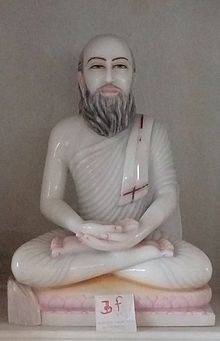Anandghan
Anandghan | |
|---|---|
 Idol in library of Lodhadham near Mumbai, Maharashtra | |
| Personal | |
| Born | Labhanand 17th century CE |
| Died | 17th century CE PossiblyMedata,Rajputana |
| Religion | Jainism |
| Sect | Śvetāmbara |
| Religious career | |
| Initiation | Labhavijay |
| Part ofa serieson |
| Jainism |
|---|
 |
Anandghanwas a 17th-centuryJain monk,mystical poet and hymnist. Though very little is known about his life, his collection of hymns about philosophy, devotion and spirituality in vernacular languages are popular and still sung inJain temples.
Life
[edit]There is no historical information available about life of Anandghan. The majority of information is based in hagiographies andoral history.[1][2][3]
He was born inRajputana(nowRajasthan,India). His dates differs according to sources. Generally 1603 or 1604 is accepted but he could have born before 1624 according to some estimation.[note 1][1][3]His childhood name was Labhanand. He was initiated as Jain monk and named Labhavijay.[4]He might belonged toTapa Gacchabranch ofMurtipujakaŚvetāmbaraJainism but Jain monastic hierarchy does not mention him. He might have lived as ascetic not associated with any organized ascetic branches. He stayed in the area of present-day northGujaratandRajasthanin India. Legends associate him withMount AbuandJodhpur.He is associated withYashovijayalso and said to have met him. He could have died inMedatain Rajasthan as a hall is dedicated to him is there. His death dates varies according to sources. Generally accepted dates are 1673 or 1674 but could have died before 1694.[note 2][1][3][5][6][7]
Works
[edit]His language is mix of vernacular languages likeGujarati,RajasthaniandBraj.It follows Rajasthani style of diction but is written in medieval Gujarati. It was the time whenBhakti movementwas at peak and majority of devotional poets of time wrote in such vernacular languages. His works are focusedbhakti(devotion) as well as internal spirituality.[1][3][5]
Anandghan Chauvisiis the philosophical treatises which supposed to contain twenty four hymns but contains twenty two. Other two hymns were later added by others. Each verse is dedicated to one of twenty four Jaintirthankaras.The legend tells that he composed these hymns in Mount Abu during his meet with Yashovijay who memorised them.[1][3][5][4][8]
Anandghan Bahattariis the anthology of hymns which differs in a number of hymns according to different manuscripts. This anthology was formed by 1775 and was transmitted orally as well as the written manuscripts. It containspada(verses) with differentragas.Some of these verses drawn from other poets likeKabir,Surdas,Banarasidasand others.[1][3][5]
Legacy
[edit]Yashovijay,the philosopher Jain monk, was influenced by him. He wrote commentary onChauvisiand also wrote eight verseAshtapadidedicated to him.[3][9][10]
His hymns are still popular in followers of Jainism as well as non-Jains because they are nonsectarian in nature and put emphasis on internal spirituality. They are sung in Jain temples. They are found in religious hymn collections especially in the collection ofDigambarahymns even though he is associated with Śvetāmbara sects. A religious camp organized byShrimad RajchandraMission ofRakesh Jhaveriin 2006 at Dharampur, Gujarat had lectures onChauvisi.Mahatma Gandhiincluded his hymn, "One may say Rama, Rahman, Krishna or Shiva, then" inAshram Bhajanavali,his prayer book.[3]
A Gujarati playApoorav Khela(2012) based on his life was produced by Dhanvant Shah and directed byManoj Shah.[11]
Further reading
[edit]- Imre Bangha; Richard Fynes (15 May 2013).It's a City-showman's Show!: Transcendental Songs of Anandghan.Penguin Books Limited.ISBN978-81-8475-985-3.
Notes and references
[edit]Note
[edit]References
[edit]- ^abcdefImre Bangha; Richard Fynes (15 May 2013).It's a City-showman's Show!: Transcendental Songs of Anandghan.Penguin Books Limited. pp. x–xxxi.ISBN978-81-8475-985-3.
- ^Manohar Bandopadhyay (1 September 1994).Lives And Works Of Great Hindi Poets.B. R. Publ. p. 68.ISBN978-81-7018-786-8.
- ^abcdefghBalbir, Nalini."Anandghan".Institute of Jainology - Jainpedia.Retrieved16 September2014.
- ^abBehramji Malabari(1882).Gujarat and the Gujaratis: Pictures of Men and Manners Taken from Life.Asian Educational Services. p. 189.ISBN978-81-206-0651-7.
- ^abcdAmaresh Datta (1987).Encyclopaedia of Indian Literature: A-Devo.Sahitya Akademi. p. 163.ISBN978-81-260-1803-1.
- ^Ronald Stuart McGregor (1984).Hindi literature from its beginnings to the nineteenth century.Harrassowitz. p. 204.ISBN9783447024136.
- ^Jeṭhālāla Nārāyaṇa Trivedī (1987).Love Poems & Lyrics from Gujarati.Gurjar Grantha Ratna Karyalaya. p. 67.
- ^John Cort (16 November 2009).Framing the Jina: Narratives of Icons and Idols in Jain History.Oxford University Press. pp. 102–.ISBN978-0-19-973957-8.
- ^Achyut Yagnik; Suchitra Sheth (2 February 2011).Ahmedabad: From Royal city to Megacity.Penguin Books Limited. p. 52.ISBN978-81-8475-473-5.
- ^Paul Dundas (2002).The Jains.Psychology Press. p. 238.ISBN978-0-415-26606-2.
- ^"નવું નાટક: આજે ઓપન થાય છે: અપૂરવ ખેલા".Gujarati Midday(in Gujarati). 1 April 2012. Archived fromthe originalon 22 August 2018.Retrieved22 August2018.
